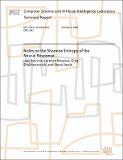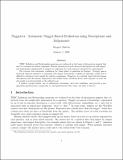Browsing Computer Science and Artificial Intelligence Lab (CSAIL) by Title
Now showing items 2226-2245 of 3804
-
A Note on Support Vector Machines Degeneracy
(1999-08-11)When training Support Vector Machines (SVMs) over non-separable data sets, one sets the threshold $b$ using any dual cost coefficient that is strictly between the bounds of $0$ and $C$. We show that there exist SVM ... -
A Note on the Computation of Binocular Disparity in a Symbolic, Low-Level Visual Processor
(1974-12-01)The goals of the computation that extracts disparity from pairs of pictures of a scene are defined, and the contraints imposed upon that computation by the three-dimensional structure of the world are determined. ... -
A Note on the Generalization Performance of Kernel Classifiers with Margin
(2000-05-01)We present distribution independent bounds on the generalization misclassification performance of a family of kernel classifiers with margin. Support Vector Machine classifiers (SVM) stem out of this class of machines. The ... -
A Note on the Optimal Allocation of Spaces in MACLISP
(MIT Artificial Intelligence Laboratory, 1977-03-16)This note describes a method for allocating storage among the various spaces in the MACLISP Implementation of LISP. The optimal strategy which minimizes garbage collector effort allocates free storage among the various ... -
A Note on the Stability Requirements of Adaptive Virtual Queue
(2002-02)Choosing the correct value for the parameters of an Active Queue Management (AQM) scheme is a well-known hard problem. The Adaptive Virtual Queue (AVQ) attempts at solving this problem by using stability requirements to ... -
Notes on PCA, Regularization, Sparsity and Support Vector Machines
(1998-05-01)We derive a new representation for a function as a linear combination of local correlation kernels at optimal sparse locations and discuss its relation to PCA, regularization, sparsity principles and Support Vector Machines. ... -
Notes on Regularized Least Squares
(2007-05-01)This is a collection of information about regularized least squares (RLS). The facts here are not “new results”, but we have not seen them usefully collected together before. A key goal of this work is to demonstrate that ... -
Notes on the Shannon Entropy of the Neural Response
(2009-10-09)In these notes we focus on the concept of Shannon entropy in an attempt to provide a systematic way of assessing the discrimination properties of the neural response, and quantifying the role played by the number of layers ... -
Notes Relating to the Design of a High Quality Image Sensor
(MIT Artificial Intelligence Laboratory, 1975-06)Some of the information that as used in arriving at a design for a high quality image input device is documented. The device uses a PIN photo-diode directly coupled to an FET-input op-amp as the sensor and two moving-iron ... -
The Notion of Security for Probabilistic Public-key Cryptosystems
(1986-10)The purpose of a cryptosystem is to allow people to communicate securely over an open channel. Before one can discuss whether a cryptosystem meets this goal, however, one must first rigorously define what is meant by ... -
A Novel Approach to Graphics
(1992-02-01)sWe show that we can optimally represent the set of 2D images producedsby the point features of a rigid 3D model as two lines in twoshigh-dimensional spaces. We then decribe a working recognition systemsin which we represent ... -
The Novice's Guide to the UNIX at the AI Laboratory Version 1.0
(MIT Artificial Intelligence Laboratory, 1988-05)This is a manual for complete beginners. It requires little knowledge of the MIT computer systems, and assumes no knowledge of the UNIX operating system. This guide will show you how to log onto the AI Lab's SUN system ... -
NUDGE, A Knowledge-Based Scheduling Program
(1977-02-01)Traditional scheduling algorithms (using the techniques of PERT charts, decision analysis or operations research) require well-defined quantitative, complete sets of constraints. They are insufficient for scheduling ... -
Nuggeteer: Automatic Nugget-Based Evaluation Using Descriptions and Judgements
(2006-01-09)TREC Definition and Relationship questions are evaluated on thebasis of information nuggets that may be contained in systemresponses. Human evaluators provide informal descriptions of eachnugget, and judgements (assignments ... -
Numerical Evidence that the Motion of Pluto is Chaotic
(1988-04-01)The Digital Orrery has been used to perform an integration of the motion of the outer planets for 845 million years. This integration indicates that the long-term motion of the planet Pluto is chaotic. Nearby trajectories ... -
A Numerical Method for Shape-From-Shading From A Single Image
(MIT Artificial Intelligence Laboratory, 1979-01)The shape of an object can be determined from the shading in a single image by solving a first-order, non-linear partial differential equation. The method of characteristics can be used to do this, but it suffers from a ... -
Numerical Shape from Shading and Occluding Contours in a Single View
(1979-11-01)An iterative method of using occluding boundary information is proposed to compute surface slope from shading. We use a stereographic space rather than the more commonly used gradient space in order to express occluding ... -
Numerical Shape from Shading and Occluding Contours in a Single View
(MIT Artificial Intelligence Laboratory, 1979-11)An iterative method of using occluding boundary information is proposed to compute surface slope from shading. We use a stereographic space rather than the more commonly used gradient space in order to express occluding ... -
Numerical Solution of Elliptic Boundary Value Problems by Spline Functions
(1968-04-01)A numerical method for solving linear, two-dimensional elliptic boundary value problems is presented. The method is essentially the Ritz procedure which uses; polynomial spline functions to approximate the exact solution. ...



















